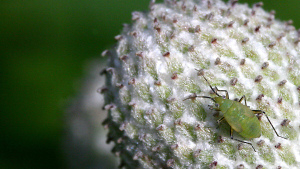Biopesticides Vs. Traditional Agrochemicals
In 2014, there is a place for both biopesticides and traditional agrochemicals in virtually all areas of agriculture. Researchers involved in fruit and vegetable, greenhouse, and row crop production say these two forms of crop protectants can be used solo or in tandem, depending on the situation. In either case, however, planning ahead is required.
In general, the biggest difference between these two classes of materials is selectivity. Most biopesticides are highly targeted in the pests they kill, and as a result have less impact on beneficials or natural enemies. Traditional agrochemicals, on the other hand, are often considered to be broad spectrum products.
Defining Biopesticides And Their Benefits
Virtually everyone in agriculture understands the definition of a traditional crop protectant. The term “biopesticide,” however, may be a little murkier to most people.
As defined by EPA, biopesticides fall into three major classes:
• Microbial pesticides consist of a microorganism (e.g., a bacterium, fungus, virus, or protozoan) as the active ingredient.
• Plant-Incorporated-Protectants (PIPs) are pesticidal substances that plants produce from genetic material that has been added to the plant.
• Biochemical pesticides are naturally occurring substances that control pests by non-toxic mechanisms.
According to Shimat Joseph, IPM entomology advisor at the University of California, no matter which class a biopesticide falls into, the product generally provides several benefits to specialty crop growers including a fast breakdown of the residue and a reduction in non-target exposure or impacts. In addition, some products, such as Bacillus thuringiensis (Bt), act on specific pests at specific life stages.
In fact, Shimat says biopesticides are often a better fit for growers if used when the pest populations are below the economic threshold or at least the action threshold for traditional materials. In the case of Bt, early season applications to combat caterpillar pests when pressure is low can provide economic benefits by reserving applications of some of the more expensive conventional products for later in the production cycle. Biopesticides’ complex modes of action also serve as an effective resistance management tool.
Angus Catchot, an entomologist at Mississippi State University, says row crop farmers can see many similar benefits with biopesticides. In particular, he says products containing a virus often are successful at suppressing pests, such as bollworms, and reducing non-target exposure, as well.
“Once [the virus] infects larvae, those larvae become a source of the virus, and it just keeps working and working,” Catchot explains. “These products actually take some of the pressure off the traditional insecticides from a resistance management standpoint.”

Aphis glycines, the soybean aphid (Aphididae); photo credit: Flickr user Jakub Vacek; Creative Commons license
Where Agrochemicals Have An Edge
In spite of their challenges regarding impact on non-target insects, traditional agrochemicals have numerous benefits.
Often a single-use active ingredient can suppress multiple pests such as thrips, aphids, or worms, Joseph says. Plus, they have longer residual activity, are likely to provide persistent control under field conditions, and the activity of the active ingredient is not likely to be affected by environmental factors, such as low humidity or high temperature.
In addition, Joseph says traditional chemicals help manage most active life stages of a pest, something most biopesticides can’t claim.
“For example, Bt is most effective on first and second instars of moth larvae,” he says. “If the larvae get bigger, Bt is no longer as effective. And, fewer numbers of sprays are required than with biopesticides. If a grower goes with synthetic pyrethroids, he just needs one or two applications. This saves money.”
Reduced cost is another positive. “Off-patent insecticides are cheaper than biopesticides or newer reduced-risk materials and provide relatively consistent results,” Joseph says.
Working In Tandem
In spite of the apparent cost benefits of off-patent traditional chemicals, using both kinds of products, sometimes in tandem, can help with resistance management, preserve beneficials, and offer a better environmental fit.
According to Catchot, often biopesticides can be rotated with other products for a cycle, reducing the chance for resistance to develop. The timing is earlier than for traditional products, however.
“Put them out earlier and on a lower pest population, particularly if [the biopesticide] is some kind of virus,” he explains. “You want to give [the virus] time to infect, sporulate, and spread.”
Raymond Cloyd, a professor in the department of entomology at Kansas State University who focuses on insecticides and miticides in greenhouse vegetable, fruit and floral production, says biopesticides and traditional agrochemicals can be used in tandem to target all stages of an insect’s life. For example, he says applying Bt early in the season will kill young caterpillars. If a second generation develops later in the season or larger caterpillars are present, a traditional material, such as a pyrethroid, can be used.
No matter the product, however, Cloyd says timing is critical.
“You want to time applications to kill the most susceptible life stage. That goes back to knowing the biology of the insect and mite pests, their behaviors, and understanding the pesticide you are using because some products are more effective on adults and some are more effective on eggs and nymphs. Make applications when the predominant life stages are susceptible to the material.”
Joseph says it is equally important to know the products’ properties. For example, biopesticides typically won’t disrupt other beneficial organisms.
“Some act on certain pests, certain life stages of the pest, function only during a given humidity/temperature range, and translocate within plants or act only by contact,” he explains.
Joseph says once growers know how the products work and interact, both traditional agrochemicals and biopesticides can be used more strategically and effectively. He adds that preferred products will have activity against the pest, attack the vulnerable life stage, and have lower residual activity.
By combining biopesticide products with these strengths and traditional chemicals that can fill in the gaps for other stages or environmental conditions, growers are, in effect, adding a whole new set of tools to their crop protection tool box.





